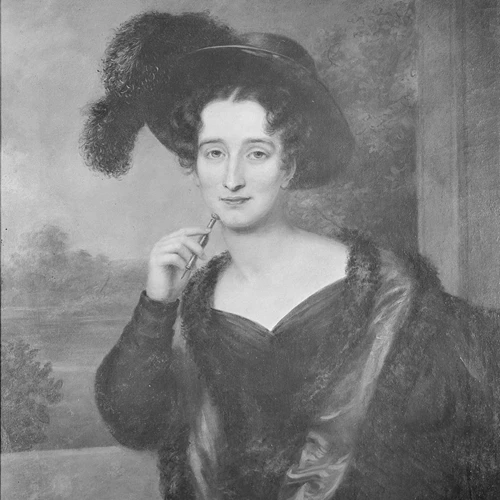Last updated: April 22, 2025
Article
Harriet Butler: Martin Van Buren’s Confidante, Decorator, and 19th-Century Gossip Girl

The story goes that a certain senator's attention last summer to a certain lady in Market Street was serious and seriously received and that the affair will terminate in a wedding…
Image credit: 1834-35 portrait of Harriet Butler. Courtesy of Frick Art Research Library
So wrote Harriet Butler on April 21, 1824, in a letter to her dear friend Martin Van Buren. It’s a line that wouldn’t be out of place in a Regency novel—or the pages of a 19th-century Gossip Girl diary. With wit and daring, Harriet playfully teased the future president about his romantic reputation, all while revealing the warmth and trust that defined their decades-long friendship.
The Butlers and the Van Burens
Harriet Butler (née Allan) and her husband Benjamin F. Butler were more than mere acquaintances of Martin Van Buren—they were his chosen family. Benjamin first became part of Van Buren’s household while clerking at his law office in Hudson, New York. Next door on Warren Street lived Harriet and her family, early settlers from Nantucket who embodied Hudson’s maritime roots. Harriet, too, was tied to that legacy—her brother, William Howard Allen, was a celebrated naval hero, remembered today in the naming of Allen Street.
Butler would go on to be Attorney General for Andrew Jackson and Martin Van Buren, as well as a life-long friend.
The Women Behind the Scenes
After Van Buren’s wife Hannah died in 1819, Harriet quietly assumed a role that went far beyond friendship. She stepped in to help manage the domestic and social duties that Van Buren’s political life required. When he ascended to the presidency in 1837, he had no First Lady to preside over the White House. It was Harriet who found him a competent housekeeper to ensure that the Executive Mansion met the expectations of the day—long before his son Abraham married Angelica Singleton, who would eventually fill that role.
When Van Buren retired to his beloved Lindenwald estate in 1841, it was once again Harriet who sprang into action. She handled much of the shopping, decorating, and provisioning to transform the house into a comfortable and dignified residence. Today, many of the furnishings admired by visitors to Martin Van Buren National Historic Site can be traced back to Harriet’s thoughtful choices.
Gossip, Wit, and Warmth
Harriet’s 1824 letter hints at her sparkle: she refers to rumors of Van Buren wooing a “certain lady in Market Street” and cheekily wonders whether a wedding was in the works. She admits to usually denying such rumors, but this time? “I shall only wonder with the wondered,” she wrote, with a knowing tone.
Whether she was needling her friend or gently encouraging him to fess up, the letter reveals Harriet’s unique place in Van Buren’s world—one of affection, familiarity, and playful honesty.
A Legacy Beyond The Footnotes
If you've strolled through Lindenwald’s halls or admired its decor, you’ve encountered Harriet Butler’s enduring influence. Beyond the furniture and flowers, she represents the quiet labor of women in history—those who shaped lives and legacies not through elected office or public accolades, but through care, intelligence, and enduring friendship.
And as for the “certain lady” of Market Street? Her name remains lost to history. But Harriet’s voice—clear, clever, and unafraid to spill a little tea—lives on.
